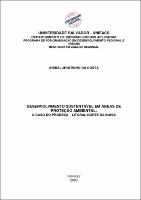| Compartilhamento |


|
Use este identificador para citar ou linkar para este item:
http://tede.unifacs.br/tede/handle/tede/207Registro completo de metadados
| Campo DC | Valor | Idioma |
|---|---|---|
| dc.creator | Costa, Anibal Moutinho da | pt_BR |
| dc.creator.Lattes | http://buscatextual.cnpq.br/buscatextual/visualizacv.do?id=K4584024E0 | por |
| dc.contributor.advisor1 | Silva, Jorge Antônio Santos | pt_BR |
| dc.contributor.advisor1Lattes | http://dgp.cnpq.br/buscaoperacional/detalhepesq.jsp?pesq=9597326937570596 | por |
| dc.contributor.referee1 | Souza, Regina Celeste de Almeida | pt_BR |
| dc.contributor.referee1Lattes | http://buscatextual.cnpq.br/buscatextual/visualizacv.do?id=K4708075E0 | por |
| dc.contributor.referee2 | Santana, Charles Dalmeida | pt_BR |
| dc.contributor.referee2Lattes | http://buscatextual.cnpq.br/buscatextual/visualizacv.do?id=K4770979T9 | por |
| dc.date.accessioned | 2016-04-29T14:11:15Z | - |
| dc.date.available | 2011-10-06 | pt_BR |
| dc.date.issued | 2009-02-17 | pt_BR |
| dc.identifier.citation | COSTA, Anibal Moutinho da. SUSTAINABLE DEVELOPMENT IN AREAS OF ENVIRONMENTAL PROTECTION: THE CASE OF PRODESU - NORTH COAST OF BAHIA. 2009. 194 f. Dissertação (Mestrado em Desenvolvimento Regional e Urbano) - Universidade Salvador, Salvador, 2009. | por |
| dc.identifier.uri | http://teste.tede.unifacs.br:8080/tede/handle/tede/207 | - |
| dc.description.resumo | A presente dissertação tem como objetivo conhecer melhor a natureza e as propostas de desenvolvimento sustentável apresentadas pela Agenda 21 principalmente nas Áreas de Proteção Ambiental (APAs), inclusive a APA do Litoral Norte da Bahia e as comunidades locais. O objeto deste estudo foi o Município de Mata de São João, em sua faixa litorânea, mais especifícamente as áreas de Praia do Forte, Açú da Torre, Diogo e Fazenda Sapiranga, no Litoral Norte da Bahia, durante o período de 1992 a 2007. Tem, também como foco as ações do PRODESU - Programa de Desenvolvimento Sustentável - implantadas pelo Governo do Estado da Bahia, quando da construção da BA-099, através do Decreto Estadual N° 1046/92, sob a responsabilidade da Companhia de Desenvolvimento Urbano do Estado da Bahia - CONDER, na qualidade de Administradora da Área de Proteção Ambiental do Litoral Norte da Bahia. O método utilizado neste estudo dissertativo está inserido no aspecto empírico e qualitativo, além da aplicação de questionários, entrevistas e da observação participante. Um dos fatores fundamentais, face ao grande potencial turístico que a Área de Proteção Ambiental do Litoral Norte da Bahia (APA-LN) proporciona, é a demanda de turistas e de pessoas de outras localidades da região metropolitana de Salvador, que buscam esses espaços para o lazer, ou para a especulação imobiliária, comprometendo a APA-LN, que fica assim, bastante vulnerável a impactos de ordem ambiental. Este quadro pode ser revertido através de uma política pública eficaz, de desenvolvimento sustentável, tanto para o turismo, como para as pessoas locais. | por |
| dc.description.abstract | This dissertation presents the have as objective sustainable development the nature and the proposals presented By Agenda 21, mainly in the fields of Environmental Conservation APA s, including the APA's northern coastline of Bahia and local communities. The object of this study is the city of Mata de Sao Joao, in its coastal region, more specifically, the areas of Praia do Forte, Açu da Torre, Diogo and Fazenda Sapiranga on the northern coast of Bahia, during the period from 1992 to 2007. It also presents a focus on the actions of RODESU-Program for Sustainable Development established by the government of Bahia State, during the construction of the BA-099, by State Decree No. 1046/92, under the responsibility of Company Urban development the government of Bahia state - CONDER, as Administrator of the Environmental Protection Area of the Northern Coast of Bahia. The method used in this study is empirical and qualitative, applying questionnaires, interviews and participant observation. One of the key factors is to observe the great tourism potential that the Environmental Preservation Area of the Northern Coast of Bahia (APA-LN) provides, the demand of tourists and people from other towns in the metropolitan region of Salvador, wich seek these spaces for the laser, or for property speculation, affect the APA LN which turning it vulnerable to the impacts of environmental. This situation can be reversed through an effective public politic of sustainable development, applyed for tourism and for local people. | eng |
| dc.description.provenance | Made available in DSpace on 2016-04-29T14:11:15Z (GMT). No. of bitstreams: 1 Dissertacao Anibal Moutinho da Costa.pdf: 4436723 bytes, checksum: bec278039e0298958f5ff52e92aa19ca (MD5) Previous issue date: 2009-02-17 | eng |
| dc.description.sponsorship | Coordenação de Aperfeiçoamento de Pessoal de Nível Superior | pt_BR |
| dc.format | application/pdf | por |
| dc.thumbnail.url | http://tede.unifacs.br:8080/tede/retrieve/710/Dissertacao%20Anibal%20Moutinho%20da%20Costa.pdf.jpg | * |
| dc.language | por | por |
| dc.publisher | Universidade Salvador | por |
| dc.publisher.department | Desenvolvimento Regional e Urbano | por |
| dc.publisher.country | BR | por |
| dc.publisher.initials | UNIFACS | por |
| dc.publisher.program | Programa de Pós-Graduação em Desenvolvimento Regional e Urbano | por |
| dc.rights | Acesso Aberto | por |
| dc.subject | Proteção Ambiental | por |
| dc.subject | Turismo | por |
| dc.subject | Desenvolvimento Sustentável | por |
| dc.subject | PRODESU | por |
| dc.subject | APA Litoral Norte | por |
| dc.subject | Bahia | por |
| dc.subject | Environmental Conservation | eng |
| dc.subject | Tourism, Sustainable Development PRODESU | eng |
| dc.subject | APA Northern coast | eng |
| dc.subject | Bahia | eng |
| dc.subject.cnpq | CNPQ::CIENCIAS SOCIAIS APLICADAS | por |
| dc.title | DESENVOLVIMENTO SUSTENTÁVEL EM ÁREAS DE PROTEÇÃO AMBIENTAL: O CASO DO PRODESU LITORAL NORTE DA BAHIA | por |
| dc.title.alternative | SUSTAINABLE DEVELOPMENT IN AREAS OF ENVIRONMENTAL PROTECTION: THE CASE OF PRODESU - NORTH COAST OF BAHIA | eng |
| dc.type | Dissertação | por |
| Aparece nas coleções: | Desenvolvimento Regional e Urbano | |
Arquivos associados a este item:
| Arquivo | Descrição | Tamanho | Formato | |
|---|---|---|---|---|
| Dissertacao Anibal Moutinho da Costa.pdf | 4,33 MB | Adobe PDF |  Baixar/Abrir Pré-Visualizar |
Os itens no repositório estão protegidos por copyright, com todos os direitos reservados, salvo quando é indicado o contrário.




